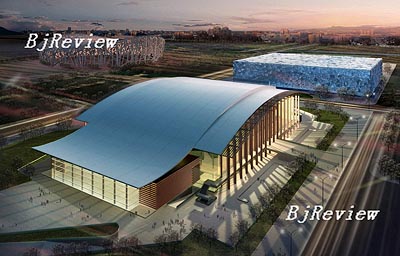
The fan has been a symbol of China for thousands of years. The earliest use of a fan is recorded in China 4,000 years ago and around 1,000 years ago folding fans were invented. Now, the iconic fan shape has inspired the design of the National Indoor Stadium.
Beijing Urban Engineering Design and Research Institute, which assumed part of the design work of the building, adopted the idea of a wavy roof mimicking an unfolded Chinese fan. This creative design, besides paying tribute to Chinese aesthetics, improves the consistency of all the Olympic buildings.
However, the fan-like design of the 81,000-square-meter stadium posed a serious technical challenge to its constructors and design team, which included architects from China Steel Construction Society and a consultation panel from the Beijing Municipal Government.
How to mount the huge roof safely on the building was a formidable engineering task since the structure's span was unprecedented. Whether the completed stadium could pass an earthquake test was another concern for designers.
To make sure the articulately calculated scheme could move from blueprint to reality, designers built a one-10th-scale model to test the design's strength at 300 different points and the results dismissed concerns. The design proved sustainable and scored high in quake tests. The design process also adopted three dimensional simulation technologies to avoid new problems popping up during the engineering stage.
Environment-friendly construction materials were used during the construction of the stadium, which are expected to become a role model for the future. The building required backfill depths of two to four meters in different places. Instead of the common backfill material of concrete using sand and gravel, exploitation of which could endanger the ecological environment, the construction of the stadium used a more environment-friendly fill made of scrap steel residue from the largest steel company in Beijing that had been piled up for years. After processing, these steel scraps were mixed with small amounts of concrete and became backfill that met national standards in density, moisture and radioactivity.
According to one stadium designer, Chen Jinke, from Beijing Urban Engineering Design and Research Institute, the novel backfill made from steel scrap saved construction costs and time, and also succeeded in recycling deserted scrap steel, which could otherwise have been garbage. "I believe this project will provide precious references for similar projects in the future," said Chen.
A total of 1,124 solar panels have been installed on the roof of the National Indoor Stadium. The panels have been installed on the roof and into the glass curtain wall at carefully designed angles, so as to avoid any aesthetic damage to the style and look of the architecture.
The designers of the project foresee a lifetime of 25 years for the solar batteries, which will generate 2.32 million kw/h of energy, the equivalent of 904.8 tons of standard coal (approximately 390 grams of standard coal are needed to produce 1 kw/h of electricity). This means that 2,352.5 tons of carbon dioxide, 21.7 tons of sulfur dioxide and 6.3 tons of nitrogen oxide will not be emitted into the atmosphere due to the use of these solar panels.
All the glass in the National Indoor Stadium has been coated with a low-emittance material. The coating reflects radiant infrared energy, thus keeping radiant heat on the same side of the glass from which it originated. This results in more efficient windows because: radiant heat originating from indoors is reflected back inside, thus keeping heat inside in the winter, and infrared radiation from the sun is reflected away, keeping it cooler inside in the summer.
As one of the three centerpiece Olympic venues, the 18,000 capacity stadium, due for completion in October, will host the artistic gymnastics, trampoline and handball tournaments, as well as wheelchair basketball for the Paralympic Games. The venue will be tested in November by two international events, the 2007 Artistic Gymnastics International Invitational Tournament and the 2007 Trampoline Gymnastics International Invitational Tournament.
To separate the audience from the athletes before the games, the stadium has designed automobile entrances especially for athletes, journalists and VIPs.
Since the National Indoor Stadium could be used to stage concerts after the Beijing Olympic Games, designers have given a lot of thought to screening the audience from any outside noise. "We have conducted rain noise tests in labs in Tsinghua University, and achieved satisfactory results. That is, we can hardly hear any noise during a rainstorm," said Zhang Guoqiang, Manager of the construction. He said the 25-cm-thick nine-layer metal protection on the interior wall is responsible for eliminating rain noise. "We have also adopted measures to eliminate noise from the air conditioning system to upgrade the sound quality of the stadium," said Zhang.
Wang Bing, a member of the design team, added that to prepare for the use of the stadium as a conference or exhibition hall in the future, the wooden floor was designed so that it can be removed in half a day. | 